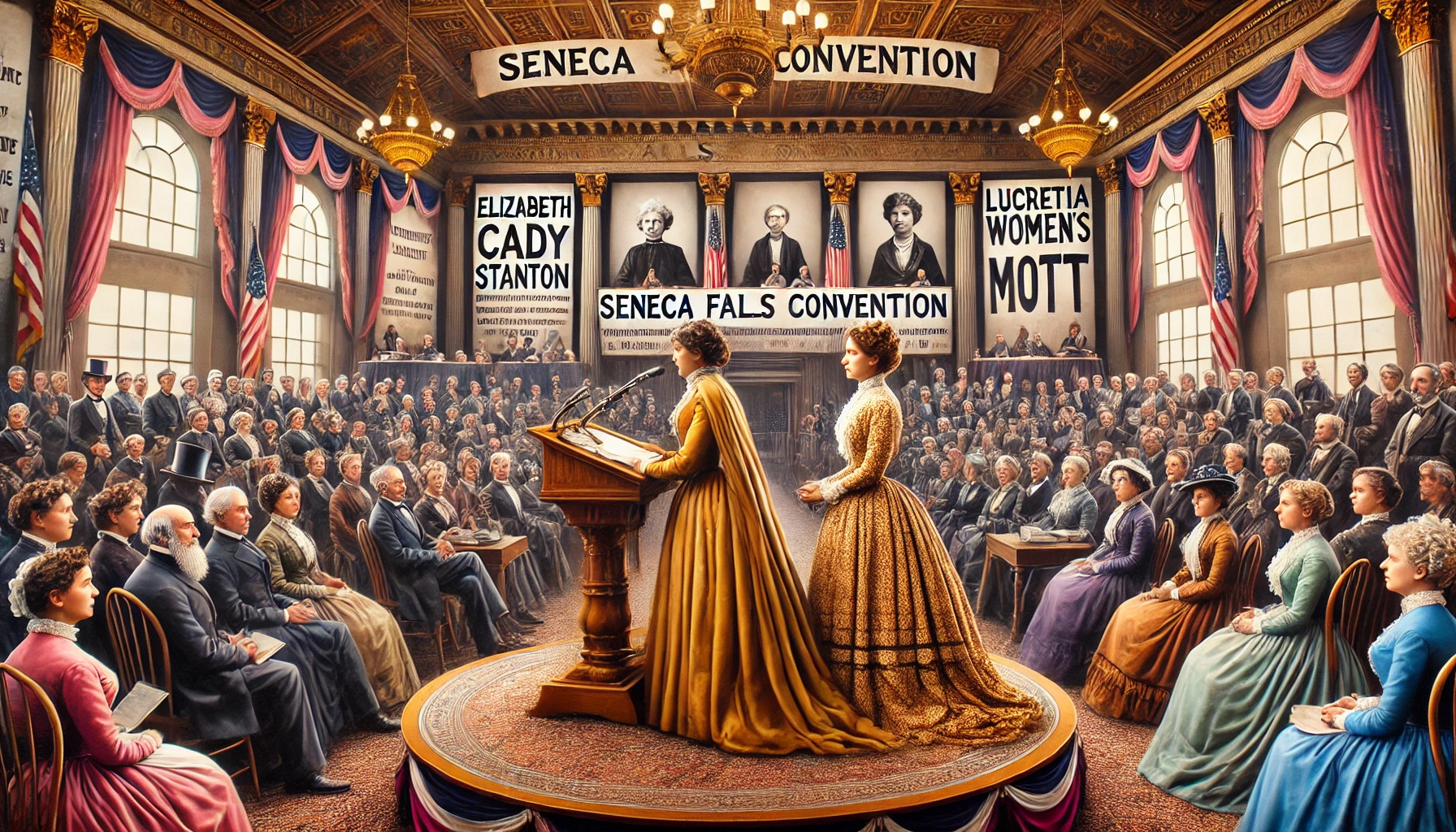
Seneca Falls Convention
July 19

The Seneca Falls Convention, held in July 1848, marks a pivotal moment in the history of women’s rights in the United States. This event is considered the first women’s rights convention, and it catalyzed the women’s suffrage movement, advocating for the essential social, civil, and religious rights of women. The convention was organized by a group of women who were active in the abolitionist movement, realizing that they, too, should advocate for their own rights.
This convention not only discussed the oppressive laws and customs that marginalized women but also resulted in the Declaration of Sentiments, a document that was modeled after the Declaration of Independence. It asserted women’s equality in all spheres and called for various rights including the controversial demand for women’s suffrage.
History and Meaning
The Seneca Falls Convention was initiated by Elizabeth Cady Stanton and Lucretia Mott along with several other women. The meeting took place in Seneca Falls, New York, at the Wesleyan Methodist Chapel and was attended by about 300 people, including men who supported the cause. The historical significance of this event lies in its role in launching the women’s suffrage movement in the United States.
The Declaration of Sentiments drafted during the convention detailed the injustices faced by women and called for action. It was signed by 68 women and 32 men, illustrating a collective acknowledgment of the need for gender equality. This document serves as a critical reference in the study of the evolution of women’s rights.
Traditions and Rituals
The Seneca Falls Convention initially did not establish specific traditions or rituals, as its primary focus was discussion and advocacy. However, over time, the commemoration of the event itself has become a tradition, especially among women’s rights groups and historians. Annual events, educational programs, and panel discussions are held to honor the progress initiated by the convention’s delegates.
Additionally, the site of the convention, the Wesleyan Methodist Chapel, has been preserved as a historical landmark. Visitors can explore exhibits and participate in guided tours that recount the pivotal moments and figures of the 1848 convention. This preservation effort helps to educate the public and promote the ongoing struggle for equality.
Modern Celebration of the Day
Today, the legacy of the Seneca Falls Convention is celebrated through various forms of public recognition and educational endeavors. Schools, universities, and women’s organizations mark the anniversary of the convention with events that highlight the history of women’s rights and discuss ongoing issues affecting women globally.
Moreover, the U.S. government has recognized the significance of the Seneca Falls Convention by establishing the Women’s Rights National Historical Park at the site. This modern celebration not only honors the past but also underscores the continuing efforts required to achieve full equality.
10 Congratulations and Wishes
- “Here’s to the brave women of Seneca Falls—may we continue to push forward in their indomitable spirit!”
- “Celebrating the courage that began in 1848—may we honor their legacy with our persistent fight for justice and equality.”
- “May the spirit of Seneca Falls ignite future generations to continue the quest for gender equality.”
- “To all who advocate for women’s rights, may your paths be inspired by the pioneers of Seneca Falls.”
- “Remembering Seneca Falls, where it all began—may we keep advancing toward a fair and equal world.”
- “Honoring the historic steps taken in 1848, may we tread our path with the same boldness and determination.”
- “May the lessons of the Seneca Falls Convention guide us as we advocate for rights and recognition for all women.”
- “Let’s continue to break barriers and build bridges, inspired by the historic assembly of 1848.”
- “Here’s to those who dare to dream of equality—may the spirit of Seneca Falls live on in each of us.”
- “As we remember Seneca Falls, let us renew our commitment to the cause of justice and equality for all.”
10 Unusual Facts
- The original Declaration of Sentiments was lost for over a century before being rediscovered.
- Not all attendees of the convention were women; about a third were men supportive of the cause.
- The idea for the convention was conceived at a tea party just days before the event.
- Elizabeth Cady Stanton’s husband, Henry B. Stanton, did not attend as he thought it might seem too controversial.
- The convention almost didn’t include the demand for women’s suffrage, as many considered it too radical at the time.
- Frederick Douglass, the noted abolitionist, played a crucial role in convincing the assembly to adopt the resolution for women’s suffrage.
- The convention was announced merely five days before it took place, yet it attracted widespread attendance.
- The Wesleyan Chapel was chosen because it was one of the few venues that allowed such a controversial topic to be discussed.
- Many of the signers of the Declaration of Sentiments faced significant social backlash.
- The Seneca Falls Convention sparked similar conventions across the United States, spreading the message far and wide.
10 Frequently Asked Questions
Q1: What was the Seneca Falls Convention? A1: The Seneca Falls Convention was the first women’s rights convention in the United States, focusing on the social, civil, and religious condition and rights of women.
Q2: Who organized the Seneca Falls Convention? A2: Elizabeth Cady Stanton and Lucretia Mott were the primary organizers, among others.
Q3: What was the Declaration of Sentiments? A3: It was a document that declared women’s equality with men and listed grievances including the lack of women’s suffrage.
Q4: Why was the Seneca Falls Convention significant? A4: It marked the start of the organized women’s rights and suffrage movements in the United States.
Q5: How many people attended the Seneca Falls Convention? A5: About 300 people attended, both men and women.
Q6: Were men supporters of the Seneca Falls Convention? A6: Yes, around 32 men attended and supported the convention, including the famous abolitionist Frederick Douglass.
Q7: What were some outcomes of the Seneca Falls Convention? A7: It raised public awareness and sparked a series of women’s rights gatherings across the country.
Q8: Did the convention face any opposition? A8: Yes, both the idea of a women’s rights convention and the Declaration of Sentiments faced significant public and private opposition.
Q9: Has the site of the Seneca Falls Convention been preserved? A9: Yes, it is now part of the Women’s Rights National Historical Park.
Q10: How is the legacy of the Seneca Falls Convention celebrated today? A10: Through educational programs, public events, and continued advocacy for women’s rights.
Conclusion
The Seneca Falls Convention of 1848 stands as a monumental event in the chronicles of human rights history, symbolizing the inception of the women’s rights movement in the United States. Its impact resonates through decades, inspiring continuous efforts toward gender equality. The courage and foresight of its organizers have paved the way for significant legal and social reforms benefiting not just women but society as a whole.
As we reflect on the importance of this day, it is crucial to acknowledge that while much has been achieved, the journey towards full equality continues. It is our responsibility to perpetuate this legacy and strive for a world where equality is not just an ideal but a reality.
How to Highlight
To effectively highlight the importance of the Seneca Falls Convention, it’s essential to incorporate it into educational curricula, encourage public discourse on gender equality, and celebrate its anniversary with meaningful events that emphasize the ongoing relevance of the issues it addressed.
Why This Day is Important
The Seneca Falls Convention is a cornerstone in the history of civil rights, marking the collective awakening and the organized effort for women’s rights. It serves as a reminder of the power of voice and action in effecting change and underscores the necessity of continuous advocacy in the pursuit of equality.
Author’s Opinion
In my view, the Seneca Falls Convention remains one of the most significant landmarks in the fight for gender equality. Its legacy teaches us about the importance of resilience and collective action in overcoming societal barriers. Celebrating this day reminds us of the unfinished business in the quest for equal rights and motivates ongoing generations to persist in this crucial endeavor.




